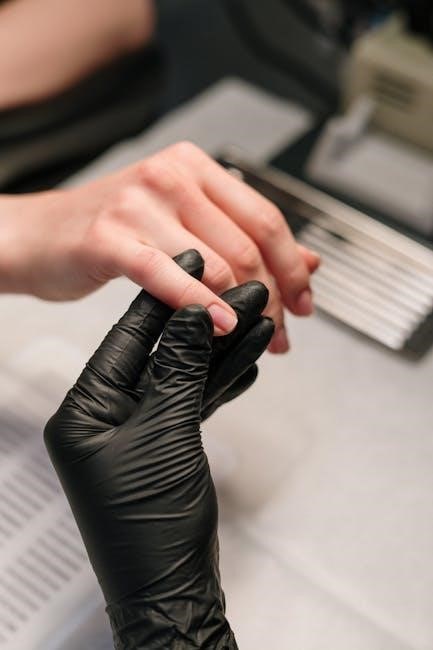The Synthes RFNA Technique Guide provides a comprehensive approach to retrograde femoral nailing for distal femur and periprosthetic fractures, emphasizing minimally invasive techniques and advanced locking systems.
1.1 Overview of the Synthes RFNA System
The Synthes RFNA System is a versatile intramedullary nailing solution designed for the treatment of distal femur and periprosthetic fractures. It combines advanced locking mechanisms with a minimally invasive approach, providing stable fixation in challenging fracture scenarios. The system features a cannulated nail design, enabling precise placement and alignment. Its retrograde approach is particularly beneficial for fractures near the knee or in the presence of prosthetic components. The RFNA System also incorporates innovative technologies, such as the Locking Polymer, which enhances screw stability and reduces toggle, improving overall fixation strength. This system is suitable for both native and periprosthetic fractures, offering flexibility and reliability in orthopedic surgical procedures.
1.2 Importance of the RFNA Technique in Orthopedic Surgery
The RFNA technique plays a critical role in orthopedic surgery, particularly for treating complex fractures of the distal femur and periprosthetic regions. Its minimally invasive approach reduces soft tissue damage, promoting faster recovery and minimizing complications. The system’s advanced locking mechanisms and cannulated design provide stable fixation, even in challenging fracture patterns. This technique is especially valuable for patients with limited bone quality or existing prosthetics, where traditional methods may fail. By offering precise alignment and enhanced screw stability, the RFNA technique improves outcomes, reducing the risk of malunions and nonunions. Its versatility and effectiveness make it a preferred choice for surgeons addressing complex femoral fractures.

History and Evolution of the RFNA System
The Synthes RFNA System has evolved significantly, with advancements in nail design, locking mechanisms, and materials, enhancing its effectiveness in treating complex femoral fractures.
2.1 Development of Retrograde Femoral Nailing
The development of retrograde femoral nailing began as a response to the challenges of treating distal femur fractures, particularly in complex cases. Early techniques focused on antegrade nailing, but limitations in addressing distal fractures led to the innovation of retrograde approaches. The Synthes RFNA System emerged as a refined solution, incorporating advanced locking mechanisms and cannulated nail designs. This evolution allowed for improved stability in periprosthetic and far distal fractures. Key advancements included the introduction of the RFN-Advanced System, which enhanced fixation options and simplified the surgical process. The technique’s development has been driven by clinical needs, emphasizing minimally invasive methods and better patient outcomes. Today, retrograde femoral nailing is a cornerstone in orthopedic trauma care.
2.2 Advancements in the Synthes RFNA System
The Synthes RFNA System has undergone significant advancements, particularly in addressing distal femur and periprosthetic fractures. The RFN-Advanced System introduced enhanced locking mechanisms, such as the Locking Polymer, which reduces screw toggle by 80% and increases pullout strength. This innovation improves stability in challenging fracture patterns. Additionally, the system’s universal design allows for both retrograde and antegrade techniques, offering flexibility for various clinical scenarios. The Advanced Nailing System also features a dedicated periprosthetic wire guide, aiding precise nail placement in the presence of prosthetics. These advancements reflect a commitment to improving outcomes, reducing complications, and streamlining surgical workflows in orthopedic trauma care.

Components and Instrumentation of the RFNA System
The RFNA System includes a cannulated titanium nail, locking screws, and instrumentation like drills and guides. It features the Locking Polymer and ASLS system for enhanced stability.
3.1 Key Components of the RFNA Nail
The RFNA Nail is a cannulated, intramedullary titanium implant designed for retrograde femoral nailing. Its key components include a durable titanium alloy construction, a cannulated core for precise screw placement, and a unique Locking Polymer that enhances distal fragment stability. The nail also features a tapered distal end to facilitate ease of insertion and a proximal locking mechanism for secure fixation. The system is complemented by advanced locking screws and the Angular Stable Locking System (ASLS), which provides superior resistance to screw toggle. Additionally, the nail accommodates both retrograde and antegrade techniques, offering versatility for various fracture patterns and patient anatomies. These components collectively ensure robust fixation and promote optimal healing in complex femoral fractures.
3.2 Instrumentation Required for the RFNA Technique
The RFNA Technique requires specialized instrumentation to ensure precise and effective implant placement. Key tools include a periprosthetic wire guide for navigating around existing prosthetics, a distal targeting device for accurate screw placement, and an Angular Stable Locking System (ASLS) kit for enhanced screw stability. A protection sleeve is used to minimize soft tissue damage during reaming, while a universal locking handle facilitates secure screw tightening. Additional instruments include cannulated drill bits for precise screw insertion and a nail insertion handle for controlled implant placement. These tools collectively enable surgeons to achieve optimal fracture reduction and stable fixation, critical for successful patient outcomes in complex femoral fractures.

Preoperative Planning and Preparation
Preoperative planning involves thorough fracture assessment, imaging analysis, and customization of the surgical strategy to ensure optimal outcomes for patients undergoing the RFNA procedure.
4.1 Patient Selection Criteria for RFNA
Patient selection for the RFNA technique involves evaluating fracture location, patient anatomy, and bone quality. Ideal candidates include those with distal femur or periprosthetic fractures requiring stable fixation. The system is suitable for fractures in the distal metaphysis or diaphysis, especially when a retrograde approach is preferred. Patients with sufficient bone stock to support locking screws and those who may benefit from minimally invasive surgery are prioritized. Additionally, the RFNA system is versatile, accommodating both retrograde and antegrade techniques, making it suitable for a range of femoral fractures, including complex cases involving existing prosthetics or prior implants. Proper patient selection ensures optimal outcomes and minimizes complications.
4.2 Imaging and Fracture Assessment
Accurate imaging and fracture assessment are critical for preoperative planning in RFNA. Standard radiographs, including anteroposterior and lateral views, are essential for evaluating fracture morphology and alignment. CT scans provide detailed insights into the fracture pattern, especially in complex or periprosthetic cases. MRI may be used to assess soft tissue involvement. Fluoroscopy is often employed intraoperatively to guide nail placement and screw insertion. Proper imaging ensures accurate measurement of the femoral canal and nail sizing, reducing the risk of malpositioning. Additionally, imaging helps identify anatomical variations or existing hardware that may influence the surgical approach. Comprehensive fracture assessment is vital for achieving optimal fixation and minimizing complications in RFNA procedures.
4.3 Surgical Planning and Strategy
Surgical planning and strategy are pivotal for successful RFNA procedures. Comprehensive preoperative planning involves analyzing fracture patterns, patient anatomy, and implant compatibility. The surgeon must determine the optimal entry point for retrograde nailing, ensuring proper alignment with the femoral canal. In periprosthetic fractures, the presence of existing hardware necessitates careful planning to avoid interference. Preoperative templating helps select the appropriate nail size and locking screw positions, minimizing intraoperative adjustments. The strategy also includes anticipating potential challenges, such as distal fragment instability, and preparing for adaptability during surgery. A well-planned approach ensures precise execution, reducing complications and improving clinical outcomes. Effective surgical strategy is tailored to the fracture complexity and patient-specific factors, ensuring a personalized treatment plan;

Surgical Technique: Step-by-Step Guide
The Synthes RFNA Technique involves precise steps: patient positioning, incision, nail insertion, locking screw placement, and wound closure, ensuring alignment and stability for optimal fracture fixation.
5.1 Patient Positioning and Anesthesia
Patient positioning is critical for the RFNA technique. The supine position is typically used, with the affected leg placed on a radiolucent table to allow fluoroscopic imaging. A lateral decubitus position may be considered for certain fracture patterns. General or regional anesthesia is administered to ensure patient comfort and immobilization during the procedure. Proper positioning ensures accurate nail placement and minimizes complications. Fluoroscopic imaging is used to confirm alignment and guide instrumentation. The operating table should be positioned to facilitate easy access for the surgical team and imaging equipment. Correct positioning and anesthesia management are essential for a successful surgical outcome.
5.2 Surgical Approach and Incision
The RFNA technique utilizes a minimally invasive retrograde approach, minimizing soft tissue disruption. A small incision is made at the distal femur, just proximal to the knee, to access the femoral canal. The incision is typically 2-3 cm in length, allowing for nail insertion while preserving surrounding tissues. Fluoroscopic imaging guides the surgical team to ensure proper alignment and placement. The approach is designed to reduce complications and promote faster recovery. Care is taken to avoid unnecessary tissue damage, facilitating optimal fracture reduction and stabilization. This method aligns with modern orthopedic principles, emphasizing precision and minimally invasive techniques.
5.3 Nail Insertion and Placement
The RFNA nail is inserted through a small incision at the distal femur, guided by fluoroscopic imaging to ensure accurate placement. The cannulated design allows for placement over a guidewire, minimizing soft tissue disruption. Once inserted, the nail is advanced into the femoral canal, ensuring proper alignment with the fracture site. The locking mechanism is then engaged to secure the nail in place, providing stability to the fracture. The nail’s design accommodates both retrograde and antegrade techniques, offering versatility for various fracture patterns. Proper placement is critical to achieve optimal fracture reduction and alignment, facilitating healing and minimizing complications.
5.4 Locking Mechanism and Screw Placement
The locking mechanism in the Synthes RFNA system ensures secure fixation of the femoral fracture. Once the nail is properly positioned, locking screws are inserted through the designated holes. The Locking Polymer technology reduces screw toggle by up to 80%, enhancing stability and pull-out strength. Cannulated screws are placed under fluoroscopic guidance to ensure precise alignment with the fracture fragments. The distal locking screws are inserted first, followed by proximal screws to complete the fixation. Proper tensioning of the locking mechanism is critical to maintain fracture reduction and promote healing. The system’s design allows for versatility in screw placement, accommodating varying fracture patterns and anatomical needs.
5.5 Wound Closure and Dressing
Following successful nail placement and screw fixation, the wound is meticulously closed to minimize the risk of infection. A sterile dressing is applied to protect the surgical site. The incision is typically closed in layers, with sutures or staples, ensuring proper alignment of soft tissues. A protective bandage may be used to immobilize the leg and reduce swelling. Antibiotic prophylaxis is continued as per hospital protocol to prevent infection. The dressing is kept dry and intact until the first postoperative follow-up. Proper wound care is crucial for promoting healing and preventing complications, especially in cases involving periprosthetic fractures or open wounds. The minimally invasive technique used in RFNA helps reduce soft tissue damage, facilitating faster recovery and minimizing scar formation.

Postoperative Care and Management
Postoperative care involves monitoring for complications, pain management, and rehabilitation. Patients undergo physical therapy to restore mobility. Follow-up imaging assesses fracture healing and hardware integrity.
6.1 Immediate Postoperative Care
Immediate postoperative care involves monitoring vital signs, managing pain, and ensuring wound integrity. Patients are closely observed for signs of bleeding or neurological deficits. Dressings are checked for drainage, and extremities are elevated to reduce swelling. Antibiotic therapy is continued as prescribed to prevent infection. Early mobilization is encouraged to promote circulation and prevent stiffness. Neurovascular checks are performed to assess nerve function and blood flow. Pain management is tailored to the patient’s needs, often involving a combination of analgesics. Patients are educated on activity restrictions and wound care before being discharged or transferred to the ward for further recovery.
6.2 Rehabilitation and Recovery Protocol
The rehabilitation protocol following RFNA surgery is tailored to promote healing and restore function. Early mobilization is emphasized, with patients encouraged to bear weight as tolerated, guided by their surgeon. Physical therapy begins shortly after surgery, focusing on range of motion exercises, strength training, and gait retraining. Patients are educated on proper wound care and activity modification to avoid complications. Assistive devices like crutches or walkers may be used temporarily. Regular follow-ups monitor progress, with imaging studies assessing fracture union. The goal is to achieve full weight-bearing status and functional recovery within 3-6 months. Compliance with the rehabilitation plan is crucial for optimal outcomes and minimizing long-term disability.
6.3 Follow-Up and Monitoring
Regular follow-up is essential to monitor healing progress and ensure proper integration of the RFNA system. Patients typically undergo clinical and radiological assessments at 6-8 weeks, 12 weeks, and 6 months postoperatively. Imaging studies, such as X-rays, are used to evaluate fracture union, nail position, and screw stability. Any signs of complications, such as hardware failure or non-union, are addressed promptly. Patient compliance with weight-bearing restrictions and rehabilitation protocols is emphasized to optimize outcomes. Long-term monitoring may extend up to 1-2 years to ensure complete recovery and functional restoration. Proper follow-up care minimizes the risk of late complications and supports the patient’s return to pre-injury activity levels.

Complications and Management
Complications such as implant failure or non-union require prompt management, often involving revision surgery or salvage techniques to restore stability and promote fracture healing effectively.
7.1 Common Complications of RFNA
Common complications of RFNA include limited implant anchorage in distal fractures, malunions, delayed unions, and nonunions. These issues often arise due to challenging fracture patterns or insufficient locking screw stability. In periprosthetic fractures, pre-existing implants can complicate nail placement, leading to suboptimal fixation. Screw toggle and pull-out are reduced by the Locking Polymer, but improper technique or inadequate preoperative planning can still result in complications. Additionally, implant failure or misalignment may necessitate revision surgery. Addressing these challenges requires precise surgical execution and adherence to the RFNA technique guide to minimize risks and ensure proper fracture stabilization.
7.2 Strategies for Complication Prevention
To prevent complications in RFNA, precise preoperative planning and imaging are crucial for accurate fracture assessment. Utilizing advanced locking systems, such as the Angular Stable Locking System (ASLS), enhances screw stability and minimizes toggle. Proper surgical technique, including correct nail placement and alignment, is essential to avoid malunions and nonunions. The Locking Polymer reduces screw pull-out, improving fixation strength. Additionally, adherence to the Synthes RFNA Technique Guide ensures optimal implant selection and placement. Postoperative care, including rehabilitation protocols, further minimizes the risk of complications. By addressing these factors, surgeons can significantly reduce the likelihood of adverse outcomes and improve patient recovery.
7.3 Revision Surgery and Salvage Techniques

Revision surgery for RFNA-related complications often involves addressing issues like implant failure, nonunion, or malunion. Salvage techniques may include replacing the existing nail with a larger or differently designed implant, such as the RFN-Advanced system, to enhance fixation. In cases of distal fragment instability, additional locking screws or supplementary plating can be used to stabilize the fracture. The periprosthetic wire guide is particularly useful in complex revisions involving prosthetics. Advanced locking systems, like ASLS, can improve screw stability and reduce toggle, minimizing the risk of further complications. Proper alignment and precise nail placement are critical during revision to achieve optimal outcomes and restore functional mobility for the patient.

Clinical Outcomes and Evidence
Clinical studies demonstrate the effectiveness of the Synthes RFNA system in achieving high union rates and reducing complication risks in distal femur fractures.
8.1 Clinical Studies on RFNA Effectiveness
Clinical studies have consistently demonstrated the effectiveness of the Synthes RFNA system in treating distal femur and periprosthetic fractures. Research indicates high union rates, with minimal complications reported. The system’s advanced locking mechanism and minimally invasive approach contribute to improved patient outcomes. Studies comparing RFNA to other fixation methods highlight its superiority in maintaining alignment and reducing screw toggle. The Locking Polymer technology, unique to the RFNA system, has been shown to increase pullout strength by up to 128%, enhancing stability in challenging fractures. These findings underscore the RFNA system’s reliability and efficacy in orthopedic surgery, making it a preferred choice for surgeons treating complex femoral fractures.
8.2 Comparison with Other Fixation Methods
The Synthes RFNA system offers distinct advantages over alternative fixation methods, such as plates or antegrade nailing. Its retrograde approach minimizes soft tissue disruption, reducing recovery time. The Locking Polymer technology enhances screw stability, a feature not found in traditional systems. RFNA’s versatility allows for both retrograde and antegrade techniques, making it suitable for various fracture types. Compared to plates, RFNA provides superior stability in osteoporotic bones and challenging distal fractures. Clinical studies show higher union rates and fewer complications with RFNA than with conventional methods. These advantages make the RFNA system a preferred choice for treating complex femoral fractures, offering improved patient outcomes and surgical efficiency.

Future Directions and Innovations
Emerging technologies and material advancements are expected to enhance the RFNA system, offering improved fixation options and expanding its applications in complex fracture management.
9.1 Emerging Technologies in RFNA
Emerging technologies in the Synthes RFNA system focus on enhancing fixation strength and versatility. The Locking Polymer technology significantly reduces screw toggle and improves pull-out strength by up to 128%, ensuring better stability. Advanced nail designs now accommodate both retrograde and antegrade techniques, offering surgeons greater flexibility. Material innovations, such as titanium alloys, provide improved biocompatibility and durability. Additionally, the integration of 3D printing for customized implants is being explored to address complex fractures more effectively. These advancements aim to expand the indications for RFNA, particularly in periprosthetic and far distal femoral fractures, where traditional methods often fall short. Such innovations underscore the system’s evolution toward more precise and adaptable solutions in orthopedic surgery.
9.2 Potential Advances in Materials and Design
Potential advances in materials and design for the Synthes RFNA system aim to enhance durability and customization. Researchers are exploring lightweight, corrosion-resistant alloys that improve biocompatibility and longevity. The integration of 3D printing technology could enable patient-specific nail designs, tailored to individual fracture patterns. Additionally, bioactive coatings are being developed to promote bone healing and reduce the risk of infection. Future designs may incorporate adaptive locking mechanisms that adjust to varying bone densities, ensuring optimal fixation. These innovations promise to expand the versatility of the RFNA system, addressing complex fractures and improving patient outcomes. Such advancements align with the growing demand for personalized and minimally invasive orthopedic solutions.
The Synthes RFNA Technique Guide represents a cornerstone in modern orthopedic surgery, offering effective solutions for complex femoral fractures. Its evolution and refinement continue to enhance patient outcomes.
10.1 Summary of Key Points
The Synthes RFNA Technique Guide provides a detailed framework for retrograde femoral nailing, addressing both straightforward and complex fractures. It emphasizes the importance of proper patient selection, preoperative planning, and precise surgical execution. The system’s advanced features, such as locking mechanisms and minimally invasive techniques, enhance stability and reduce complications. Clinical evidence highlights improved outcomes for distal femur and periprosthetic fractures. The guide serves as a valuable resource for orthopedic surgeons, combining theoretical knowledge with practical step-by-step instructions. By adhering to its principles, surgeons can achieve optimal results, minimizing recovery times and maximizing patient mobility. This comprehensive approach solidifies the RFNA system’s role as a cornerstone in modern orthopedic surgery.
10.2 Final Thoughts on the RFNA Technique
The Synthes RFNA Technique Guide represents a significant advancement in orthopedic surgery, offering a versatile and reliable solution for treating complex femoral fractures. Its emphasis on retrograde nailing provides surgeons with a minimally invasive approach, reducing recovery times and improving patient outcomes. The system’s advanced locking mechanisms and compatibility with various fracture types make it a preferred choice for both distal and periprosthetic fractures. By adhering to the guide’s principles, surgeons can achieve consistent results, minimizing complications and enhancing patient mobility. The RFNA technique underscores the importance of precision and proper technique, solidifying its role as a cornerstone in modern orthopedic care.
